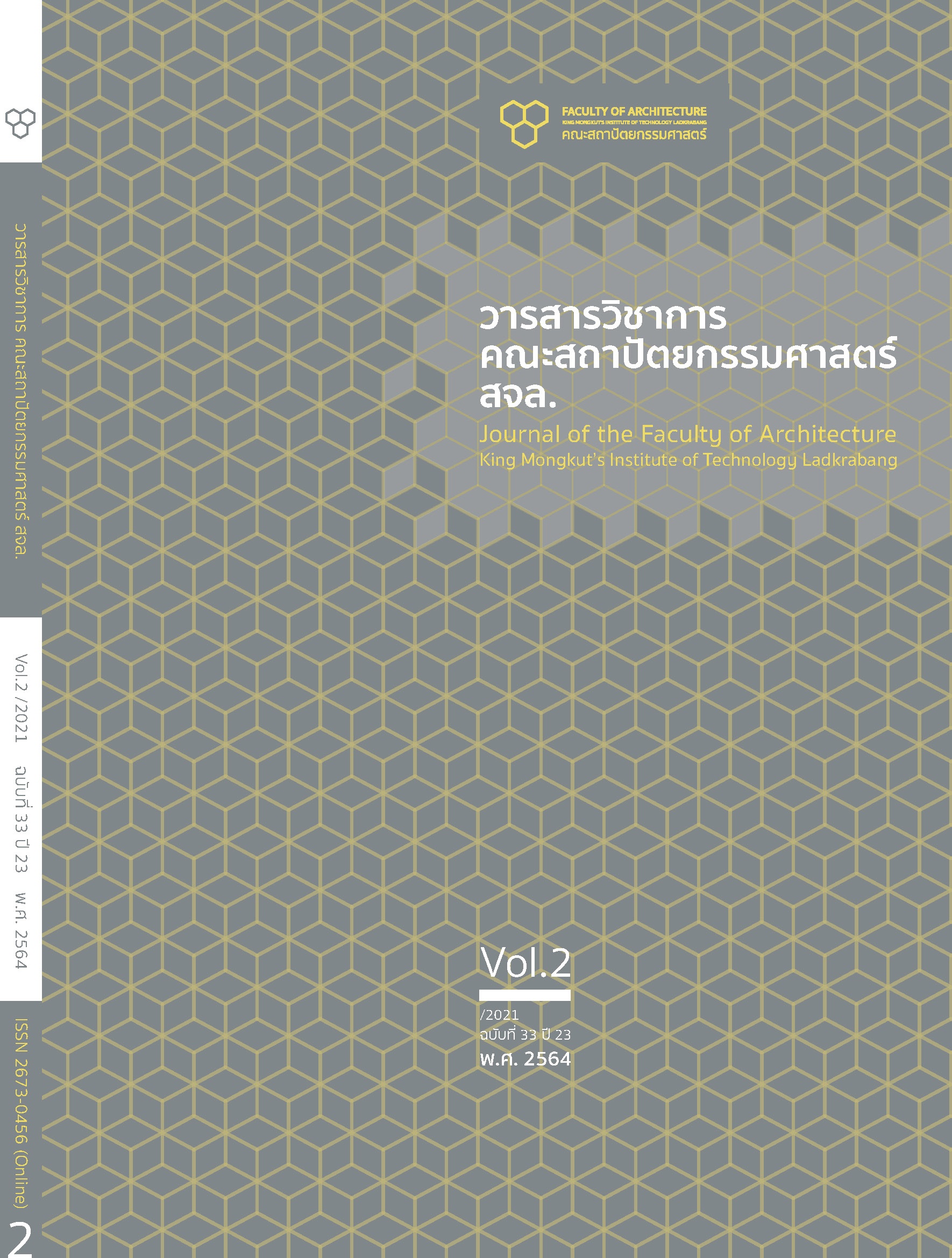Patterns of Urak Lawoi vernacular houses during the permanent settlement in Baan Toh – Baliew community, Krabi province
Main Article Content
Abstract
This article aims to study the patterns of Urak Lawoi vernacular houses during the permanent settlement in the Baan Toh – Baliew community. These houses appeared when they could no longer use traditional boats to migrate to food sources—causing the question of what does the house patterns of the sample group? Including what factors do relate? The research hypothesis is that people's culture influences the characteristics of their houses, and it is not a standstill. Therefore, when the Urak Lawoi people switch from a nomadic lifestyle to a permanent settlement, their houses represent the adjustment of the living area to suit their specific culture and the culture of the people in the new land. The research method was a field survey, selecting the sample by the purposive sampling method with precise conditions selected as the criteria. The result shows that the patterns of Urak Lawoi vernacular houses during the permanent settlement blend a traditional and modern house, reflecting the adaptation of the social trend that changes its popularity over time and leading to an increase in factors and conditions to respond to the living. They are causing the patterns of houses to change from the original. Nevertheless, it still shows the continuity of wisdom in the building, which they inherit and adapt to suit the changing context. The related factors are 1) the use of fishing tools by other groups of people, 2) the collection of things and food, 3) cohabitation of many sub-families, 4) adoption of modern technology into their lives, 5) adoption of foreign cultures in the living space, and 6) respect for other beliefs.
Article Details
This work is licensed under a Creative Commons Attribution-NonCommercial-ShareAlike 4.0 International License.
Copyright Transfer Statement
The copyright of this article is transferred to Journal of The Faculty of Architecture King Mongkut's Institute of Technology Ladkrabang with effect if and when the article is accepted for publication. The copyright transfer covers the exclusive right to reproduce and distribute the article, including reprints, translations, photographic reproductions, electronic form (offline, online) or any other reproductions of similar nature.
The author warrants that this contribution is original and that he/she has full power to make this grant. The author signs for and accepts responsibility for releasing this material on behalf of any and all co-authors.
References
ชนัญ วงษ์วิภาค. (2530). นิเวศน์วิทยาวัฒนธรรม. กรุงเทพฯ: โรงพิมพ์มหาวิทยาลัยศิลปากร.
ดาฤนัย จรูญทอง. (2550). ประวัติศาสตร์ชุมชนอูรักลาโว้ยเกาะหลีเป๊ะ จังหวัดสตูล ระหว่างปี พ.ศ. 2493 - 2549. (วิทยานิพนธ์ปริญญาอักษรศาสตรมหาบัณฑิต สาขาวิชาประวัติศาสตร์ บัณฑิตวิทยาลัย, มหาวิทยาลัยศิลปากร).
ธนภรณ์ วัฒนสุข. (2557). อูรักลาโว้ยการเปลี่ยนแปลงของสังคมสู่พัฒนาการของเรือนพื้นถิ่น: กรณีศึกษาชุมชนแหลมตุ๊กแก หมู่ 4 ตำบลรัษฎา อำเภอเมือง จังหวัดภูเก็ต. (วิทยานิพนธ์ปริญญาศิลปศาสตรมหาบัณฑิต สาขาวิชาสถาปัตยกรรมพื้นถิ่น บัณฑิตวิทยาลัย, มหาวิทยาลัยศิลปากร).
นฤมล อรุโณทัย, พลาเดช ณ ป้อมเพชร, อุษา โคตรศรีเพชร, กิ่งแก้ว บัวเพชร และจีระวรรณ บรรเทาทุกข์. (2557). ทักษะวัฒนธรรมชาวเล ร้อยเรื่องประมาณชาวเล มอแกน มอแกลน และอูรักลาโว้ย ผู้กล้าแห่งอันดามัน. กรุงเทพฯ: ศูนย์มานุษยวิทยาสิรินธร (องค์การมหาชน).
ปริญญา มรรคสิริสุข และวีระ อินพันทัง. (2563). จาก “นิเวศวิทยาวัฒนธรรม” สู่ “นิเวศวิทยาสถาปัตยกรรม”. หน้าจั่ว. (35), B3-B18.
พิไลวรรณ ประพฤติ. (2558). การศึกษาความยั่งยืนของการดำรงชีพบนเกาะขนาดเล็กของชาวอูรักลาโว้ย: กรณีศึกษาเกาะหลีเป๊ะ ประเทศไทย. (วิทยานิพนธ์ปริญญาปรัชญาดุษฎีบัณฑิต สาขาวิชาการจัดการทรัพยากรเกษตรเขตร้อน บัณฑิตวิทยาลัย, มหาวิทยาลัยสงขลานครินทร์).
เมธิรา ไกรนที. (2552). พัฒนาการของการตั้งถิ่นฐานชุมชนอูรักลาโว้ยในพื้นที่ภูเก็ตจากมุมมองนิเวศวัฒนธรรม. (วิทยานิพนธ์ปริญญาศิลปศาสตรมหาบัณฑิต สาขาวิชาพัฒนามนุษย์และสังคม บัณฑิตวิทยาลัย, จุฬาลงกรณ์มหาวิทยาลัย).
วีระ อินพันทัง. (2555). เรือนลาวโซ่ง การกลายรูปในรอบสองศตวรรษ. กรุงเทพฯ: อุษาคเนย์.
วีระ อินพันทัง. (2559). สิ่งแวดล้อมสรรค์สร้างพื้นถิ่น: การดำรงและการเปลี่ยนแปลง. หน้าจั่ว. (30), A-127–A-142.
วีระ อินพันทัง, ปริญญา มรรคสิริสุข, อัมพิกา อําลอย, อดิศร ศรีเสาวนันท์, เจนยุทธ ล่อใจ และพบสุข ทัดทอง. (2563). สถาปัตยกรรมพื้นถิ่นไทย. กรุงเทพฯ: สมาคมสถาปนิกสยามในพระบรมราชูปถัมภ์.
อัมพิกา อำลอย. (2562). การตั้งถิ่นฐาน และที่อยู่อาศัยของชาวเลภายใต้บริบทของความเปลี่ยนแปลง. (วิทยานิพนธ์ปริญญาปรัชญาดุษฎีบัณฑิต สาขาวิชาสถาปัตยกรรมพื้นถิ่น บัณฑิตวิทยาลัย, มหาวิทยาลัยศิลปากร).
อัมพิกา อำลอย และวีระ อินพันทัง. (2562). สถาปัตยกรรมพื้นถิ่นแบบเคลื่อนที่ของชาวเล: กรณีศึกษา ชาวมอแกนในหมู่เกาะสุรินทร์ จังหวัดพังงา และชาวอูรักลาโว้ยในบ้านโต๊ะบาหลิว เกาะลันตาใหญ่ จังหวัดกระบี่. เจ-ดี: วารสารวิชาการ การออกแบบสภาพแวดล้อม. 6(2), 2 - 19.
อัมพิกา อำลอย, วีระ อินพันทัง และชินศักดิ์ ตัณฑิกุล. (2562). ปัจจัยในการตั้งถิ่นฐานชั่วคราวของชาวเลจังหวัดพังงา และจังหวัดกระบี่. วารสารวิชาการคณะสถาปัตยกรรมศาสตร์ สจล. 29(2), 34 - 46.
อาภรณ์ อุกฤษณ์. (2532). พิธีลอยเรือ: ภาพสะท้อนสังคมและวัฒนธรรมของชาวเล กรณีศึกษาชุมชนบ้านหัวแหลม เกาะลันตา จังหวัดกระบี่. (วิทยานิพนธ์ปริญญาศิลปศาสตรมหาบัณฑิต สาขาวิชามานุษยวิทยา บัณฑิตวิทยาลัย, มหาวิทยาลัยศิลปากร).
Sutton, M.Q. and Anderson, N. E. (2013). Introduction to Cultural Ecology (Third Edition). Maryland : AltaMira Press.


